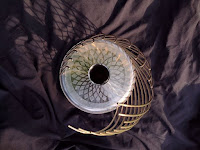 |
| Modern Day Waterphone |
A waterphone, or an ocean harp, is a very unique instrument. It's crafted from a metal resonating bowl with a grip in the center, and prongs along the outer rim. Water can be added to the bowl to change pitch and sound resonance. They are fairly easy to play, although it's difficult to hold melody or rhythm. They can be played either with a bow or percussively. The waterphone creates an eerie shrill hum which has been described as a "sirens song". Its distinct sound has made it be primarily used in sound effects or soundtracks, but several rock musicians have also experimented with it. I've always wanted to play the waterphone, and I love being able to hear its cry in horror movies or in background sounds.
But how did this strange instrument come to be? In 1969, an American sculptor and painter known as Richard Waters fused together the German nail violin, kalimbas, and the Tibetan water drum. His result, an odd little device capable of producing shrieking calls and vibrations. There isn't much available surrounding the early stage of the instrument, but we do know Waters filed for a patent in 1975. Throughout the 1980's, we start to see the waterphone be used in psychedelic rock and folk music. Musicians like Tom Waits and Mickey Hart have several pieces primarily using the instrument.
Waterphone Moan
Over the next several decades, the waterphone became a staple in horror/suspense movies. Some of which include Poltergeist, Let The Right One In, Aliens, and my personal favorite, Gordon Ramsey's Kitchen Nightmares. Several orchestras and musicals have also begun incorporating the instrument. One musical, Howard Goodalls, The Dreaming; a musical based off of Shakespeare's Midsummer Night's Dream, uses the unsettling sound of the waterphone to capture the mystery and danger of the woods. Composer Robert Minden has also done his part in keeping the sound alive, as his ensemble uses the waterphone as their main instrument to create some ethereal and unique sounds.
Z1000
 |
| Hyperstellar Sailophone |
Despite staying unchanged for decades, in 2018 the waterphone got an update. The Hyperstellar Sailophone, is very similar to its predecessor, with one key difference. Instead of the short upright rods of the waterphone, the hyperstellar sailophone features curved long rods. Which function to provide better control over the second harmonic as well better range to hit lower frequency vibrations.
In short, an instrument that originated from the tinkering of a bored college kid has not only transformed into an eerie staple of thriller movies and reality TV shows but is also kept alive by many small artists and musicians who don't want the waterphone to fade away. Although we're still in the beginning phase of the waterphones evolution, I look forward to seeing what the future has to bring.
Citations
“Waterphone.” Wikipedia, 17 Oct. 2020, en.wikipedia.org/wiki/Waterphone.
Clark, Brian. “The Waterphone (How It Works, What It Sounds Like, Where to Buy One).” Musician Wave, 23 July 2020, www.musicianwave.com/waterphone/.
The Waterphone (How it Works, What it Sounds Like, Where to Buy One) - Musician Wave
"A Brief History of the Waterphone.” AquaSonic Waterphone, 3 Aug. 2012, www.thewaterphone.com/1436/.A Brief History of the Waterphone
I always wondered what instrument was used to create those eerie sounds in horror movies and games. The moment I watched the first video, I knew it was this instrument. The waterphone is definitely an interesting instrument!
ReplyDeleteHey Eva, I have never heard of the waterphone before, but it seems very fascinating! The sounds that it produces reminds me of the wind chimes I have on my back porch. It seems like a fairly easy instrument to learn, but I looked up the prices and they are going for around 150-250 dollars on average. Even though it is a very interesting instrument, I do not think it is meant for me.
ReplyDeleteHi Eva! This is such a cool instrument that I've never heard of before. It's interesting that it's an instrument that many people know by its sound, but could never guess what it actually looks like. I find the sound of the waterphone kind of ugly which is why it fits so well in reality TV or horror movies, but I also wonder what relationship the water phone has to songs which use wine glasses filled with water to create beautiful sounds. One instrument I found was the glass armonica which was invented by Benjamin Franklin just about 200 years before the waterphone was invented. I wonder what relationship, if any, the two instruments really share and if there was any inspiration from the glass armonica which helped to inspire the creepier sounding waterphone.
ReplyDeleteHere is an example of the glass armonica:
https://www.youtube.com/watch?v=eQemvyyJ--g
Thanks for teaching me about this cool instrument!
Hey Eva, I have not heard of this instrument before, and it fascinates me. I listened to the videos you have attached to your post and agree that this instrument can add a suspenseful note to any piece of music, especially to horror movies, as you said. You would enjoy some other nontraditional musical instruments like the Aztec death whistle. It was used during the battle but also occasionally in their songs. Overall this was a good post and I enjoyed looking at your post as well as the aesthetic of your posts.
ReplyDelete